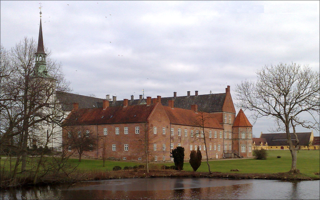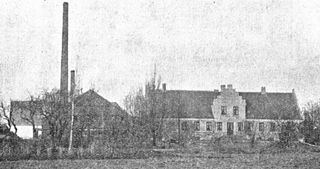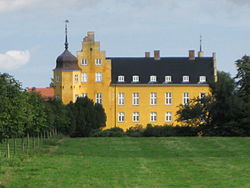
The Reventlow family is a Holstein and Mecklenburg Dano-German noble family, which belongs to the Equites Originarii Schleswig-Holstein. Alternate spellings include Revetlo, Reventlo, Reventlau, Reventlou, Reventlow, Refendtlof and Reffentloff.

Brahetrolleborg is a castle about 10 kilometres north-west of Fåborg on the Danish island of Fyn. Before the Reformation, the structure was a Cistercian monastery known as Holme Abbey. After the reformation, the property was renamed Rantzausholm in 1568 before receiving its current name in 1667.

Rudbjerggaard, situated 7 km south of Nakskov, is the only half-timbered manor house on the island of Lolland in south-eastern Denmark.

Torbenfeldt Castle is a manor house located 15 km south-west of Holbæk on the island of Zealand in eastern Denmark. The estate covers 1,711 hectares of land (2000).

Gisselfeld, a former monastery, is Denmark's fifth-largest estate. Located between Haslev and Næstved, it extends into several municipalities but the main building is located in Braaby Parish in Faxe Municipality. The estate measures 3,850 hectares, including Hesede, Edelesminde, Brødebæk and Gødstrupgård, of which 2,400 hectares is forest. The three-storeyed Renaissance-style building has stepped gables, loopholes and a projecting tower over the main gate. The grounds include a moat, a well-kept park, lake, waterfall, gardens, greenhouse, and a fountain. A recent addition in its forest is a 45 meter tall hyperboloid tower.

¨Bramsløkke is a manor house on the island of Lolland in southeastern Denmark. The main building is from c. 1690 and was listed on the Danish registry of protected buildings and places by the Danish Heritage Agency on 31 December 1959. The estate has been owned by the Mærsk Mc-Kinney Møller since 1939. It covers 243.1 hectares.

Egholm is a manor house and estate situated on the Hornsherred Peninsula, between Kirke Hyllinge and Skibby, in Lejre Municipality, some 60 km west of Copenhagen, Denmark. The Neoclassical main building from 1824, a gatehouse from 1870, a barn from 1880, a stable from circa 1890 and a former horse mill were listed on the Danish registry of protected buildings and places in 1998. Another building is now operated as an arms museum under the name Egholm Museum. The estate covers 770 hectares of land.

Sæbyholm was a manor house located close to Maribo on the island of Lolland in southeastern Denmark. The estate was acquired byChristian Heinrich August Hardenberg-Reventlow of Krenkerup in 1801 and has been owned by his descendants since then. The three-winged main building and the home farm were listed on the Danish registry of protected buildings and places in 1960. The buildings were delisted in 2012 and demolished in 2013.

Christianssæde is a manor house and estate located close to Maribo on the island of Lolland in southeastern Denmark.
Lungholm is a manor house and estate located on the island of Lolland in southeastern Denmark. It has been owned by members of the Lehn family since 1784. The three-winged main building was listed on the Danish registry of protected buildings and places in 1988. It consists of a main wing from 1856 and two side wings from the 16th or early 17th century.

Orebygaard is a manor house and estate located on Lolland in southeastern Denmark. The current main building, a Neo-Renaissance style building with two towers, is from 1872–1874. It was listed on the Danish registry of protected buildings and places in 1985.
Alslevgaard is a manor house and estate located at Karise, Faxe Municipality, Denmark. The estate was for 300 years owned by the Grubbe family and has for long periods of time shared ownership with Tryggevælde. Both estates belonged to the Countship of Bregentved from 1751 to 1922 under grevskabet Bregentved, der blev oprettet af A. G. Moltke. The old main building was demolished in the middle of the 18th century and a new main building was not built until 1902. The oldest parts of the farm buildings (avlsgården) dates from circa 1775.

Næsbyholm is a manor house and estate located east of Tybjerg Lake, between Sorø and Glumsø, in Næstved Municipality, some 70 km (43 mi) southwest of Copenhagen, Denmark. Since 1610, Næsbyholm and Bavelse have had the same owners. The three-winged Dutch Renaissance-style main building was reconstructed after fires in 1932 and 1947, incorporating elements from 1585. It is now used as a venue for weddings, conferences and other events. The scenic park was laid out in the 18th century. The Næsbyholm-Bavelse estate covers 1,424 hectares of land (2012), of which approximately half is forest.

Otte Steensen Brahe, also known as Otto Brahe, was a Danish landowner and money lender. He owned Næsbyholm, Bavelse and Tersløsegaard on Zealand.

Steen Ottesen Brahe was a Danish privy counsellor and landowner.

Kjærstrup, or Kærstrup, is a manor house and estate located 9 kilometres East of Rødbyon Lolland, Lolland Municipality, in Southeastern Denmark. The two-storey, half-timbered main building was faced with brick in 1836 and a central tower in the front was added in 1868. The building was listed on the Danish registry of protected buildings and places in 1918. The adjacent farm buildings date from the early 1910s and are not part of the heritage listing. A Baroque style garden from around 1765 was restored in around 1900. The estate covers 487 hectares of land.

Tølløsegård, also known as Tølløse Castle, is a former manor house and estate located at Tølløse, Denmark. It has since 1997 been operated as a school under the name Tølløse Slots Efterskole. The current main building was built after a fire in 1944.

Peder Munk of Estvadgård (1534–1623), was a Danish navigator, politician, and ambassador, who was in charge of the fleet carrying Anne of Denmark to Scotland. The events of the voyage led to witch trials and executions in Denmark and Scotland.

Nybøllegård is a manor house in Funen, Denmark. It has been in the possession of a number of Danish noble families, including the Rosenkrantz and Bille families.
Sindinggård is a manor house situated next to Sinding Church in Herning Municipality, Denmark. The oldest part of the three-winged main building was constructed for Franz Ranzau in 1730. It was listed in the Danish registry of protected buildings and places in 1939.




















